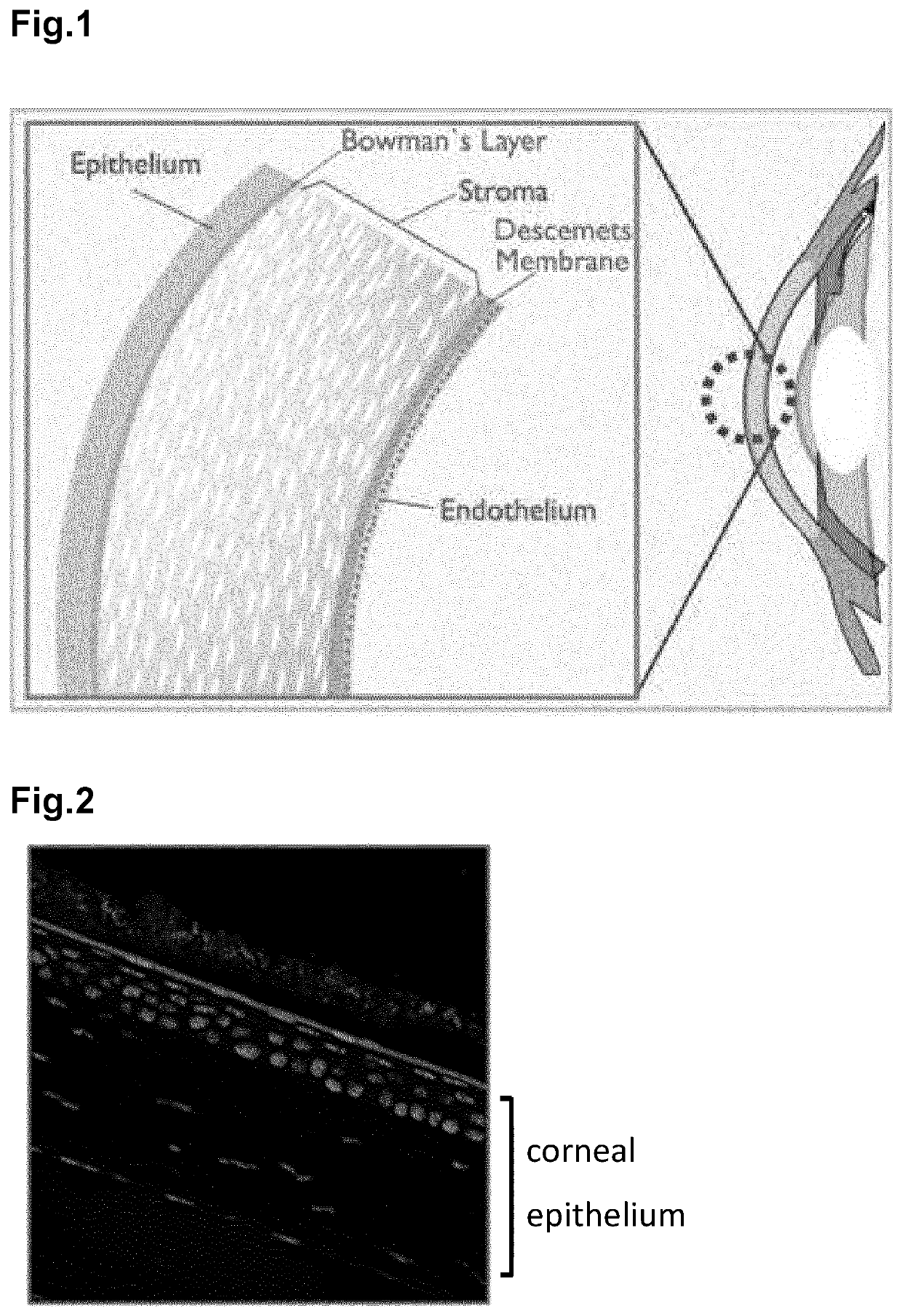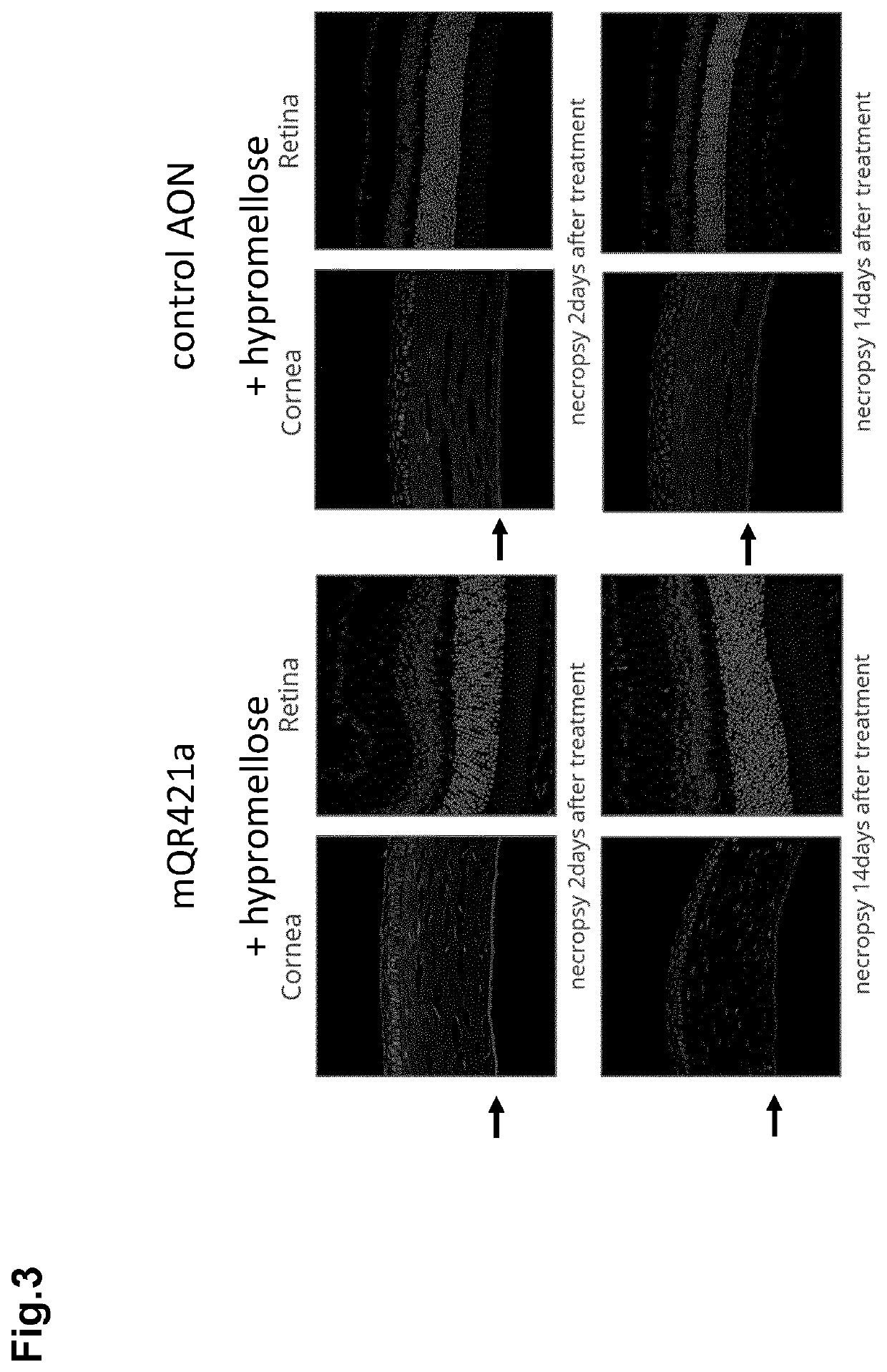Opthalmic compositions comprising viscosifying polymers and nucleic acids
- Summary
- Abstract
- Description
- Claims
- Application Information
AI Technical Summary
Benefits of technology
Problems solved by technology
Method used
Image
Examples
example 1
of Single-Stranded Antisense Oligonucleotides (AONs) to the Corneal Endothelium Through Topical Administration
[0073]Usher syndrome (USH, or just ‘Usher’) and non-syndromic retinitis pigmentosa (NSRP) are degenerative diseases of the retina. WO 2016 / 005514, WO 2017 / 186739 and WO 2018 / 055134 disclose AONs for the treatment of Usher by targeting retinal cells for splice modulation of the USH2A pre-mRNA (exon 13 and exon 50 skipping, as well as skipping of pseudo exon 40, or PE40, form the USH2A pre-mRNA). Although the AONs are meant to target the retina, one of the AONs, also referred to as QR-421a (or in fact its mouse equivalent mQR421a, see WO2018 / 055134) was used by the inventors of the present invention in an initial trial experiment to see whether it could be traced back in all layers of the cornea after topical administration (applying it to the corneal epithelium) on the mouse eye. mQR421a would serve as a control nucleic acid. For this, 200 μg mQR421a (40 μg / μl) was locally ad...
example 2
l Downregulation of Transcript Expression in Corneal Endothelium After Topical Application of a Gapmer, Using Hypromellose as a Penetrating Enhancer
[0075]The inventors then questioned whether it was possible to show a functional effect of applying a nucleic acid molecule through topical administration (onto the corneal epithelium, using hypromellose) and delivering the nucleic acid molecule to all the layers of the cornea. For this, a certain type of oligonucleotide was chosen, generally referred to as a gapmer, which is a single-stranded antisense oligonucleotide molecule generally containing two wings segments comprising RNA nucleosides and a center part that is made of DNA. The gapmer hybridizes to its target sequence and causes a nuclease breakdown of the resulting double-stranded complex, thereby downregulating the expression of the target RNA. As a target, the inventors selected Metastasis Associated Lung Carcinoma Adenocarcinoma Transcript 1 (MALAT1), which serves here as an ...
example 3
the Retina After Topical Application of a Nucleic Acid Molecule
[0080]The inventors wondered whether the functional effect of applying a nucleic acid molecule through topical administration (onto the corneal epithelium, using hypromellose) as described above would be limited to the corneal layers or whether the retina would also be reached. In the case of corneal endothelial disorders, it is preferred that the healthy retina is not reached, where it may potentially cause unwanted side-effects. Like what has been described above, the investigators selected the gapmer that targets MALAT1, which serves here as an example only. MALAT1, also known as NEAT1 is a large, infrequently spliced non-coding RNA (IncRNA) that is highly conserved amongst mammals and highly expressed in the nucleus.
[0081]The mouse specific MALAT1 gapmer (SEQ ID NO: 1) was formulated and administered as described above. Both the left and right eye of three mice were treated (six eyes in total). Three treatment groups...
PUM
| Property | Measurement | Unit |
|---|---|---|
| Affinity | aaaaa | aaaaa |
| Toxicity | aaaaa | aaaaa |
Abstract
Description
Claims
Application Information
 Login to View More
Login to View More - R&D
- Intellectual Property
- Life Sciences
- Materials
- Tech Scout
- Unparalleled Data Quality
- Higher Quality Content
- 60% Fewer Hallucinations
Browse by: Latest US Patents, China's latest patents, Technical Efficacy Thesaurus, Application Domain, Technology Topic, Popular Technical Reports.
© 2025 PatSnap. All rights reserved.Legal|Privacy policy|Modern Slavery Act Transparency Statement|Sitemap|About US| Contact US: help@patsnap.com



